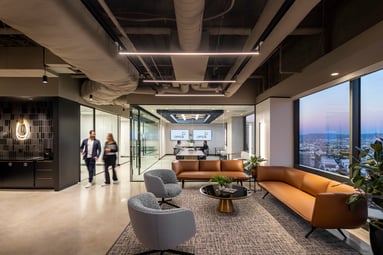
2020 was a challenging year for the co-working market, but we expect it will become a popular choice for companies looking for interim solutions to mitigate pandemic-induced disruption and uncertainty. However, as Steve Quick, Global CEO at Unispace explains, “co-working isn’t always a silver bullet and can mean organizations are giving up more than they bargained for."
There is no doubt that the global commercial real estate market has taken a major hit as entertainment, retail and office space has been operating at significantly lower capacity since early 2020. CBRE predicts property values for these spaces won’t begin to recover until 2022 or later. Despite restrictions and lockdown measures across the globe, the progress of the co-working movement is expected to grow globally, doubling by 2024.
Some industry commentators are proclaiming the future of workplace is having co-working spaces on every street corner. Others are pointing to examples such as HSBC and Deloitte embracing co-working as evidence of its growing appeal as a viable real estate solution. Other companies like IBM and Microsoft have been using co-working as a flexible option for their employees for several years. This trend is expected to continue to accelerate over the next five years as business owners look for alternatives for their long-term leases and employees insist on greater flexibility. “Not only is there a lot of chatter around the benefits of co-working right now, but it’s easy to see the appeal of these facilities—with their promise of greater flexibility and no long-term commitments—for any organization looking to hedge their bets amid the ongoing uncertainty,” says Quick.
Flexibility and co-working don’t always go together
Before everyone rushes to the nearest available co-working facility, it’s worth examining the long-term implications of giving up your workplace and migrating to someone else’s space. We believe future workplace needs are going to require hybrid strategies, like our Propeller workplace model. Hybrid workplaces offer a progressive alternative from the outdated 9-5 culture. The office will serve as a destination environment for activities like socializing, collaboration, innovation, and revenue generation. Conversely, tasks like focus work and training will be done in a remote setting.
"Co-working facilities are good at offering flexibility around desk space, but we don’t foresee that being a pressing priority for most businesses," says Quick. “They aren’t particularly well-placed to support versatile hybrid environments. Organizations who use co-working offices will find they’re more restricted in what they can do with their physical space."
Design with community in mind
Co-working providers pride themselves on the sense of shared community they curate. Investments are often focused on the design of communal spaces, comfortable and designer furniture, beer taps, and fresh fruit to entice companies to join their communities. This may be a compelling option for start-ups interested in providing their teams with dynamic work environments and opportunities to mingle alongside like-minded organizations. According to Harvard Business Review, “connecting with others and feeling part of a community is a big reason for why people pay to work in a communal space."
For companies that already have a clearly defined culture, moving to a co-working office could be a compromise. “Your physical work environments play a role in upholding and reinforcing culture, from the graphics and imagery representing your brand to the working habits encouraged by the design and layout of the space,” explains Quick. “In a co-working space, however, the environment is ultimately designed for the provider’s culture and identity, not yours."
The cost of getting stuck
Another trade-off for lease flexibility is the cost of the space itself. Co-working facilities were originally designed to cater to fast-growing businesses that regularly outgrew their spaces and were willing to pay extra for the flexibility to move out/upgrade at short notice.
While a co-working environment might be a practical short-term solution for an organization uncertain about the future or nearing the end of their existing lease, long-term commitments end up costing more than negotiating leasing arrangements for owned space.
“It’s easier than you might think to get ‘stuck’ in a co-working environment," says Quick. “Maybe your employees are reluctant to move again, or you’re struggling to find the right permanent space. Either way, you end paying more the longer you stay."
Landlords recognize the need for greater flexibility
One of the biggest impacts of the pandemic has been the end of inflexible, long-term office leases. Landlords are showing more willingness to renegotiate on space and agree on shorter terms—even if leases are a long way from expiry.
If your business is facing real estate challenges, consider all the possibilities before opting to part with your owned workspace. As Quick concludes, “if you’re considering co-working, you need to ask yourself, do you really see this as a permanent solution for your workforce, and if not, what does your future plan look like?”
To better understand how owned office spaces can be adapted to meet the needs of your business, download our post-Covid workplace guide.
| For more information about location strategies and future workplace solutions, download our location guide HERE. |
We're wrapping our Re:location series with an article focused on landlords and brokers. Stay tuned for the final article, Re:location: The landlord shift and broker strategies: Redefining relationships.


